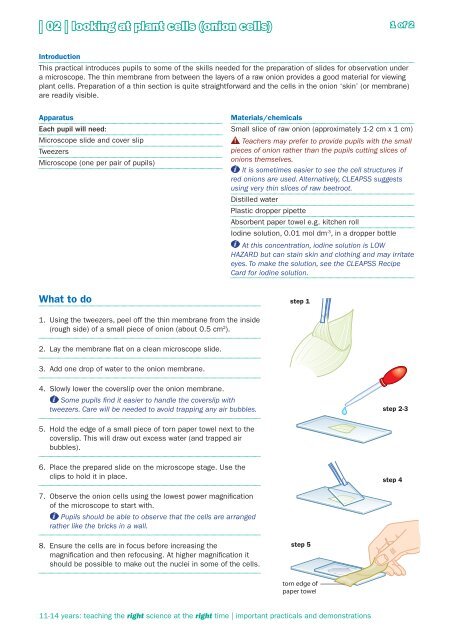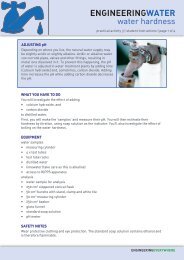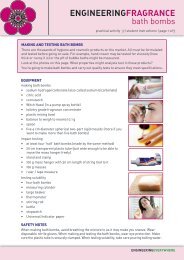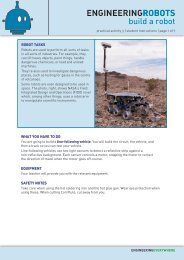| 02 | looking at plant cells (onion cells) - 4science
| 02 | looking at plant cells (onion cells) - 4science
| 02 | looking at plant cells (onion cells) - 4science
You also want an ePaper? Increase the reach of your titles
YUMPU automatically turns print PDFs into web optimized ePapers that Google loves.
| <strong>02</strong> | <strong>looking</strong> <strong>at</strong> <strong>plant</strong> <strong>cells</strong> (<strong>onion</strong> <strong>cells</strong>) 1 of 2<br />
Introduction<br />
This practical introduces pupils to some of the skills needed for the prepar<strong>at</strong>ion of slides for observ<strong>at</strong>ion under<br />
a microscope. The thin membrane from between the layers of a raw <strong>onion</strong> provides a good m<strong>at</strong>erial for viewing<br />
<strong>plant</strong> <strong>cells</strong>. Prepar<strong>at</strong>ion of a thin section is quite straightforward and the <strong>cells</strong> in the <strong>onion</strong> ‘skin’ (or membrane)<br />
are readily visible.<br />
Appar<strong>at</strong>us<br />
Each pupil will need:<br />
Microscope slide and cover slip<br />
Tweezers<br />
Microscope (one per pair of pupils)<br />
M<strong>at</strong>erials/chemicals<br />
Small slice of raw <strong>onion</strong> (approxim<strong>at</strong>ely 1-2 cm x 1 cm)<br />
Teachers may prefer to provide pupils with the small<br />
pieces of <strong>onion</strong> r<strong>at</strong>her than the pupils cutting slices of<br />
<strong>onion</strong>s themselves.<br />
It is sometimes easier to see the cell structures if<br />
red <strong>onion</strong>s are used. Altern<strong>at</strong>ively, CLEAPSS suggests<br />
using very thin slices of raw beetroot.<br />
Distilled w<strong>at</strong>er<br />
Plastic dropper pipette<br />
Absorbent paper towel e.g. kitchen roll<br />
Iodine solution, 0.01 mol dm -3 , in a dropper bottle<br />
At this concentr<strong>at</strong>ion, iodine solution is LOW<br />
HAZARD but can stain skin and clothing and may irrit<strong>at</strong>e<br />
eyes. To make the solution, see the CLEAPSS Recipe<br />
Card for iodine solution.<br />
Wh<strong>at</strong> to do<br />
step 1<br />
1.<br />
2.<br />
3.<br />
Using the tweezers, peel off the thin membrane from the inside<br />
(rough side) of a small piece of <strong>onion</strong> (about 0.5 cm 2 ).<br />
Lay the membrane fl<strong>at</strong> on a clean microscope slide.<br />
Add one drop of w<strong>at</strong>er to the <strong>onion</strong> membrane.<br />
4.<br />
Slowly lower the coverslip over the <strong>onion</strong> membrane.<br />
Some pupils find it easier to handle the coverslip with<br />
tweezers. Care will be needed to avoid trapping any air bubbles.<br />
step 2-3<br />
5. Hold the edge of a small piece of torn paper towel next to the<br />
coverslip. This will draw out excess w<strong>at</strong>er (and trapped air<br />
bubbles).<br />
6.<br />
Place the prepared slide on the microscope stage. Use the<br />
clips to hold it in place.<br />
step 4<br />
7. Observe the <strong>onion</strong> <strong>cells</strong> using the lowest power magnific<strong>at</strong>ion<br />
of the microscope to start with.<br />
Pupils should be able to observe th<strong>at</strong> the <strong>cells</strong> are arranged<br />
r<strong>at</strong>her like the bricks in a wall.<br />
8. Ensure the <strong>cells</strong> are in focus before increasing the<br />
magnific<strong>at</strong>ion and then refocusing. At higher magnific<strong>at</strong>ion it<br />
should be possible to make out the nuclei in some of the <strong>cells</strong>.<br />
step 5<br />
paper towel<br />
11-14 years: teaching the right science <strong>at</strong> the right time | important practicals and demonstr<strong>at</strong>ions
| <strong>02</strong> | <strong>looking</strong> <strong>at</strong> <strong>plant</strong> <strong>cells</strong> (<strong>onion</strong> <strong>cells</strong>) 2 of 2<br />
9.<br />
10.<br />
The procedure can be repe<strong>at</strong>ed using a drop of iodine solution instead of w<strong>at</strong>er in Step 3. This should<br />
make it easier to pick out the basic cell structures. It is worth pointing out th<strong>at</strong> the pupils will not be able<br />
to see any chloroplasts in the <strong>onion</strong> <strong>cells</strong>.<br />
Clear away and wash hands.<br />
Teachers should consider a safe way for all the used slides and coverslips to be collected.<br />
11-14 years: teaching the right science <strong>at</strong> the right time | important practicals and demonstr<strong>at</strong>ions






